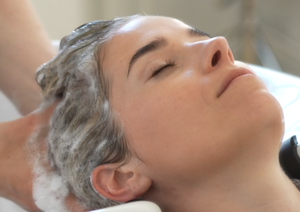Understanding the specific characteristics of curly hair
Curly hair has unique characteristics that require appropriate care and cutting techniques to maintain its beauty. This article explains how to cut curly hair, focusing on the fundamental aspects you need to understand before picking up scissors. By following these tips, you'll be able to manage your curls with care and precision.
Characteristics of curly hair
The structure of curly hair
Curly hair is distinguished by its distinctive structure. Unlike straight hair, every curly hair has a helical shape that can vary from loose waves to tight curls. This structure determines not only the hair's appearance, but also its behavior. The cuticles of curly hair are not as smooth, which can make the hair more prone to dryness and frizz.
The needs of curly hair
Due to its specific structure, curly hair has different needs from other hair types. It requires regular moisturizing and products that define and maintain curls without weighing them down. The choice of hair care products, such as shampoos, conditioners and stylers, should be made with these unique needs in mind, to avoid common problems such as frizz and lack of curl definition.
Why is it difficult to cut curly hair?
The risk of excessive volume
One of the major challenges of cutting curly hair is the risk of creating excessive volume. When curly hair is cut inappropriately, it can swell and give a "triangle" effect, where the mass is concentrated at the bottom of the cut. A specific technique must be used to stagger curls without adding unnecessary volume.
The risk of losing curls
Another challenge when cutting curly hair is the loss of curl definition. Incorrect cutting can stretch and relax curls, making them less defined and more difficult to style. To avoid this, it's crucial to cut hair with its natural texture and curl shape in mind.

Pre-cut preparation
Choosing the right time for cutting
When should curly hair be cut?
Choosing the right time to cut curly hair is essential to maximizing curl definition and health. Unlike straight hair, curly hair does not grow evenly. So it's best to cut when curls are in their natural state, usually after washing and drying. This allows us to see the true length and behavior of the curls, facilitating a precise and appropriate cut.
The importance of healthy hair
Before cutting, it's crucial to ensure that the hair is in good health. Curly hair tends to be drier and more fragile, so a rigorous hair care routine is necessary. Using moisturizing and nourishing products helps keep hair in good condition and makes cutting easier and more efficient. Well-moisturized hair cuts better and is less likely to develop split ends or break.
The tools you need for a good cut
Using the right scissors
The choice of scissors is crucial to the successful cutting of curly hair. Professional hairdressing scissors, especially those designed for cutting texturized hair, are best. Avoid using household or DIY scissors, as they are not precise enough and can damage the hair. Professional-quality scissors deliver clean, precise cuts, minimizing the risk of split ends.
The right comb for curly hair
A wide-tooth comb is ideal for detangling curly hair without breaking curls or making them frizzy. Before cutting, use this type of comb to remove knots and separate curls into homogeneous sections. Avoid using fine combs, which can break the hair and disrupt the natural curl structure. For a more detailed cut, a wooden comb can also be a good option, as it reduces static electricity and helps hold curls in place.
Cutting techniques for curly hair
Comb cutting
Combing is a technique commonly used for curly hair. It involves combing each section of hair before cutting the ends evenly. This method helps control length and preserve curl shape. It's important to work slowly and regularly check the uniformity of the cut to ensure an even result with no surprises.
Brush cutting
Brush cutting can be particularly useful for those with tight or highly textured curls. By using a special brush for curly hair, you can slightly loosen the curls before cutting them. This technique helps achieve a more precise cut and avoids cutting too much length by mistake. It's essential to cut curly hair when it's dry or slightly damp to achieve a more precise length, as curly hair shrinks considerably as it dries.
Practical tips for cutting
How to handle scissors
Handling scissors with care is crucial to successfully cutting curly hair. Hold the scissors at a slightly inclined angle, and make quick, small cuts rather than large slashes. This method helps retain the natural volume of curls while avoiding unnatural, straight ends. Always cut hair following the natural contour of curls and respecting their direction of growth.
How to respect the shape of curls
To keep curl definition intact, it's essential to follow the natural shape of the curls when cutting. Don't pull too hard on the curls before cutting, as this can distort the actual length and lead to a cut that's too short. Work on small sections at a time, taking into account the shape of the curls.
See also: How to style curly hair?
The process of cutting curly hair
Cutting techniques for curly hair
Comb cutting
Combing is a technique commonly used for curly hair. It involves combing each section of hair before cutting the ends evenly. This method helps control length and preserve curl shape. It's important to work slowly and regularly check the uniformity of the cut to ensure an even result with no surprises.
Brush cutting
Brush cutting can be particularly useful for those with tight or highly textured curls. By using a special brush for curly hair, you can slightly loosen the curls before cutting them. This technique helps achieve a more precise cut and avoids cutting too much length by mistake. It's essential to cut curly hair when it's dry or slightly damp to achieve a more precise length, as curly hair shrinks considerably as it dries.
Practical tips for cutting
How to handle scissors
Handling scissors with care is crucial to successfully cutting curly hair. Hold the scissors at a slightly inclined angle, and make quick, small cuts rather than large slashes. This method helps retain the natural volume of curls while avoiding unnatural, straight ends. Always cut hair following the natural contour of curls and respecting their direction of growth.
How to respect the shape of curls
To keep curl definition intact, it's essential to follow the natural shape of the curls when cutting. Don't pull too hard on the curls before cutting, as this can distort the actual length and lead to a cut that's too short. Work on small sections at a time, taking into account the natural shape of the curls to avoid distorting them. Use your fingers to hold sections slightly taut but without forcing the strand, then cut following the natural curve of the curl.
Split into sections
A key step in the process of cutting curly hair is to separate the hair into sections. This helps to control the cut and ensure an even distribution of curls. Start by dividing hair into four main sections: top, bottom, left and right. Then work in smaller subsections for greater precision. Use clips to hold sections in place and keep other strands out of the way. Working section by section allows you to keep an eye on the overall cut and adjust as necessary to the natural structure of the curls.
Respect the length
When cutting curly hair, it's important to cut less than you initially think, especially if it's your first time or if you're not totally sure of your desired length. Curly hair bounces and shrinks a lot more once dry, which can result in a cut that's much shorter than expected. For this reason, start by cutting a small amount and adjust gradually. This minimizes mistakes and ensures that the hair length is exactly what you want.
The thinning technique
To avoid excessive volume, thinning is a technique often used. This method involves removing some of the hair's density without affecting overall length. This can be done using thinning scissors, which have serrated blades, allowing some hair to be cut while leaving others intact. This technique is particularly useful for very thick or tightly curled hair that can build up in mass in certain areas. When lightening, it's crucial to do so evenly and evenly to avoid an uneven appearance.
Avoid straight cuts
Straight cuts are generally not recommended for curly hair, as they can create harsh, unnatural lines. Instead, opt for angled or layered cuts.

FAQ and final tips for cutting curly hair
FAQ: Frequently asked questions about cutting curly hair
1. How often should I cut my curly hair?
We recommend trimming curly hair every 8 to 12 weeks to eliminate split ends and maintain curl shape.
2. Is it better to cut curly hair when it's dry or damp?
It's generally best to cut curly hair when it's dry or slightly damp, so that you can see its true length and shape, allowing for a more precise cut.
3. Can I use household scissors to cut my curly hair?
No, we strongly recommend using professional hairdressing scissors. Household scissors are not precise enough and can damage hair by creating split ends.
4. How to avoid frizz after a haircut?
To avoid frizz, use moisturizing products before and after cutting, and be sure to use sharp scissors. Avoid excessive handling of hair during cutting.
5. What's the best technique for cutting curly hair at home?
The best technique is to divide the hair into sections, work slowly and cut the ends following the natural shape of the curls. Use a wide-tooth comb and professional scissors for best results.
H3: Final tips for a successful cut
H4: Use suitable products
To maintain the beauty and definition of your curls, it's crucial to use the right hair care products. Opt for sulfate-free, moisture-rich shampoos and conditioners. Styling products should also help define curls without weighing them down.
H4: Adapt cut to hair type
Cutting techniques vary according to curl type. If you have loose curls, a layered cut can provide volume and definition. For tighter curls, a more structured cut can help avoid excessive volume and maintain curl shape.
H4: Avoid straight cuts
Straight cuts create harsh, unnatural lines for curly hair. Prefer angled or layered cuts for a more natural, harmonious look. This allows curls to form freely without creating heaviness in certain areas.
H4: Take your time
Cutting curly hair takes more time and patience than cutting straight hair. Take your time to work section by section, regularly checking length and shape. This will help you avoid mistakes and achieve an even cut.
H4: Consult a professional
If you're not sure of your skills, or if your curly hair requires specific techniques, don't hesitate to consult a professional. A hairdresser who specializes in curly hair will know which method is best suited to your needs.
Conclusion
Cutting curly hair can be a challenge, but with the right techniques and tools, it's possible to maintain its beauty and health. By following these tips and taking the time to understand the specifics of your curls, you can achieve a successful cut that enhances their natural structure.





